A lightweight Type 59
The first Chinese light tank developed by and for the People's Liberation Army was the Type 62. The Soviet T-54, locally produced with the help of USSR in a brand new factory on the north, not only gave birth to four main classes of main battle tanks but also countless derivatives. The Type 59 was considered too heavy for military operations in many parts of Southern China, due to the varied soft ground encountered in many areas, rice paddies, hilly terrain, marshes, and rivers without a bridge strong enough to support the weight of a regular MBT. A requirement was born in 1957, and Factory 674 (Harbin First Machinery Building Group Ltd) was put in charge of the project in 1958. The first prototypes was built, tried and refined between 1960 and 1962, and accepted for service at the end of the year, hence the "62". Production and deliveries started in 1963.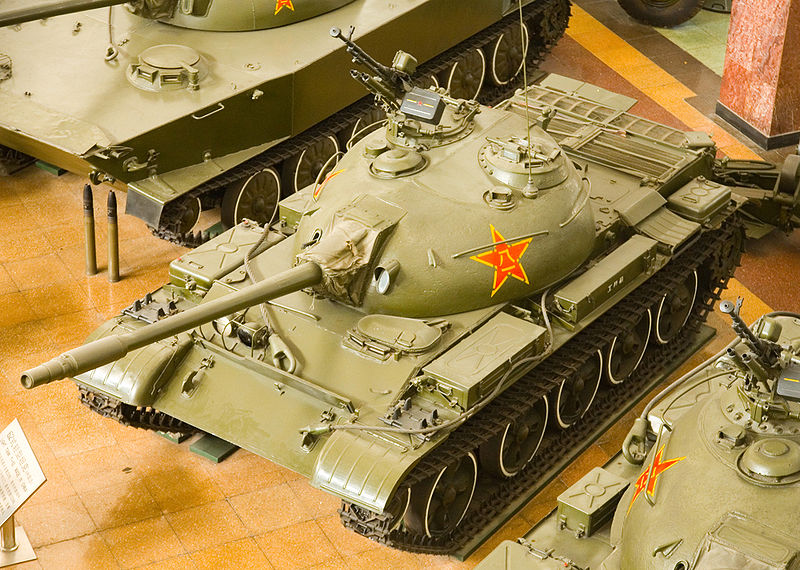
Design of the Type 62
Differences with a regular Type 59 are not obvious but nevertheless relatively easy to pick up. In a binocular when in a rough ride in the fever of an engagement, this is another matter. The gun is the most obvious one, with a shorter barrel and modified bore evacuator. Seen from profile, the Type 62 seemed also shorter, that it was indeed. It was conceived as a lightweight Type 59 and the weight only speaks for itself: Only 21 tons, compared to the 36 tons of the Type 59, itself lighter than the T-54. This was obtained by shortening the hull between the first and second roadwheel pairs, rear plate, and have the turret shifted slightly more to the front. The hull was only 5.6 m long, compared to the Type 59 6.04 m, and 7.9 m overall.The whole armor was way much thinner, at only 35 mm on the glacis (203 mm for the Type 59), and 50 mm on the turret front, but 15 mm elsewhere. Equipment was downgraded or made lighter too. The crew configuration remained standard, with the driver seated on the left hand side of the hull front, the tank commander and gunner seated on the left side of the turret in tandem and the loader on the right hand side, the rear of the turret. The driver has three periscope vision blocks and the center could be removed and replaced by a low-light periscope, 50 m vision range.
The left turret hatch had another periscope for the commander and another in the front of each turret hatch. The loader also operates the 12.7 mm Type 54 anti-aircraft heavy machine gun mounted on a rotatable mount on the roof (1250 rounds). An 85 mm Type 62-85TC rifled main gun replaced the 100 mm, with a modified fume extractor. It is known to fire AP, APHE, HE, Frag-HE, HEAT, APFSDF-T and smoke rounds, at a maximum range of 12,200 m for a practical direct fire range of 1,870 m at 3/5 rpm. But accuracy was poor due to the simplified optics. There was no gun stabilizer for example, which forbid fire on the move.
47 rounds were in store with ready rounds in the turret, and the remainder probably under the floor and sides of the hull. This armament was completed by one coaxial Type 59T 7.9 mm machine-guns, possibly used for aiming and target spotting, and one mounted in the bow of the hull. A third one, optional, could be mounted on left hand side turret hatch, for additional AA firepower (2000 rounds in all). The turret also had a radio left hand side of the turret, in front the turret hatch, a mushroom-shaped smoke evacuator. The rounded and rectangular boxes on the fenders can take the stowage.
The powerplant was a 12150L-3 V-12 liquid cooled diesel giving 430 hp (321 kW) at 1,800 rpm, which combined with the lightweight hull have excellent characteristics, with a power to weight of 20.5 hp/tonne (15.3 kW/tonne) and a top speed of 60 km/h on flat, 35 km/h cross country, and a range of 500 km on road. Like the type 59 and T-54/55, there is an injection system for raw diesel fuel into the exhaust manifold to produce a potent smoke screen. The suspension system was unchanged in appearance but the roadwheels were in reality thinner and lighter. The tracks width was also reduced in the result, but the ground pressure was nevertheless keep very low due to all the weight-saving measures elsewhere.
Evolution
The Type 62-I
As reports came from the Sino-Vietnamese front, showing the losses of the Type 62 to RPGs, a modification program was launched, called the WZ131A (factory designation) of Type 62-I, comprising 33 different improvements. These includes an external double lens laser range finder mounted above the gun mantlet, a shield for the 12.7 mm HMG, and protection improvements which details are unknown, probably add-on armor, either bolted or welded, although few photos are available to show these alteration. No side skirts were apparently fitted either. The upgrade process started in 1979. In the 1980s, another upgrade saw the adoption of external turret storage racks, an at least hull side skirts to protect against HEAT rounds & missiles. The numbers of conversions are unknown, but inferior to 400 (the official total of upgrades combining the G types).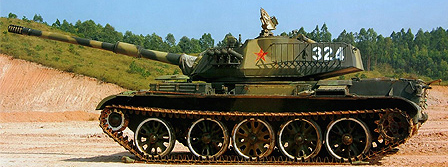
The Type 62G
The upgrade process to Type 62G standard started in 2000. The G stands for Gai or "Improved". This includes improved armor layout and the old cast turret replaced by a new welded flat-plate turret incorporating an improved spaced and possibly composite armor, with four smoke grenade dischargers on each side. The firepower is reinforced by a standardized 105 mm rifled main gun of the same type as the late Type 59, a band new vertical stabilization system, a fire-control system, and night vision sights for the driver, commander and gunner. These upgrades are common to the Pakistani Al-Zarrar & Al-Khalid.The Type 70
A sub-type emerged by the integration of the 62-I external double lens laser range finder. It was mounted above the mantlet of the Type 62-85TC rifled main gun. However the heavy machine gun is devoid of shield, but the gun also received a stabilization system and all sights are improved. The range of modifications to the protection is unknown (if some) as the conversion numbers of this model.Variants
The Type 79 was an experimental armored recovery vehicle which was less advanced than the GJT 211 and Type 82. Only two specialized, operational variants are known in China: The engineering GJT 211 equipped with a dozer blade, and the GSL 131 or Type 82 mine-clearing variant of the first. They are heavily modified vehicles, as the upper hull is replaced by an armored cabin with shutters at the front and a large hydraulic power-pack at the rear for a V-shaped dozer blade. The Type 82 is propelled by a 430hp V-12 diesel engine and had two GBD 127 mine clearing charges for a combat weight of 25.10 tons.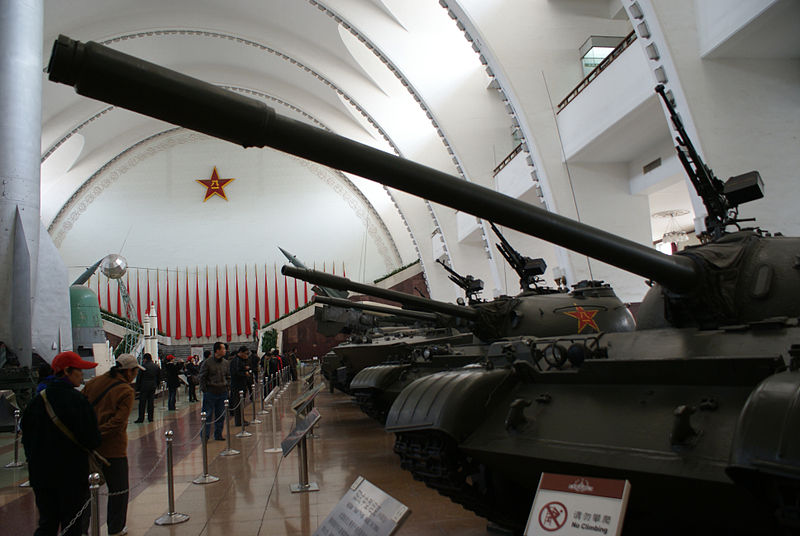
Operators
The Type 62 was even a cheaper proposition to the Type 59 and was exported (to some extant according to the less impressive production) to 12 other countries. All but three of these keep the Type 62 in service as of today. According to Wikipedia, the cumulative figures of exportation are of 556 vehicles.Africa
Customers of this cheap tank includes the Democratic Republic of the Congo (48), and the Republic of the Congo (8). These came from an original order from Zaire (70 in 1975), split for the survivors of the civil war into both Congo republics. Mali also ordered 18 light tanks in 1980, as well as Sudan (70 ordered in 1970), and Tanzania (66 in two batches, the first ordered in 1969 and the last in 1972). This represent a total of 210 potentially active tanks today.Bangladesh
Bangladesh ordered 36 vehicles in 1984. They were all later reconverted. 14 into APCs and 22 into 105 mm self-propelled gun with a central fixed casemate. Both types are still operational today.North Korea
Although there is some confusion for western experts about the Ch'ŏnma-ho, based on the T-62 (and not the abbreviated form of the "Type-62"), 50 of these tanks were nevertheless ordered in 1971 (delivered in 1971-1972) and remained in service at least until 1995.South-Western Asia
Cambodia purchased 30 of these, including 20 ordered in 1977, delivered the next year, and Vietnam which received 200 tanks, most active during the latter part of the war, as well as Thailand (30). All these countries still operates the type as of today.Operational history
According to the official logs (now part of the giant Norinco corporation) more than 1393 WZ131 (the factory designation) were produced between 1963 and 1989, in several evolution, and more for export. The Type 62 was deployed in Southern China, one of this being the recon battalion organic to the 43rd Army Group HQ, Guangzhou Military Region. This unit saw its combat debut in the Vietnam War, supplied to the North Vietnamese forces (NVA) before the invasion of Kampuchea. These soldiered intensively in the 1960s-1970s as well as the Ho Chi Minh Campaign in 1975. In 1979 the Type 62s were again deployed, this time during the Sino–Vietnamese War. PLA's local forces had some 200 tanks in Northern Vietnam, most being the light Type 62. Although well fit for the mountainous terrain, they took heavy losses to hand-held rocket-propelled launchers (RPGs) in particular. This triggered even before the end of the hostilities a wide scale upgrade package (Type 62-I). Also as a result of the heavy losses (50%) the Type 62 was relegated to secondary duties in Southern China. Although a precise figure of how many of these tanks and of what types are used in various units, in January 2005 CCTV showed two Type 62G light tanks belonging to the Guangzhou MR artillery regiment as the organic recon unit. Both the G and I/II were retired from Chinese service in early 2013, but goes on in several countries, often in the original, non-upgraded version. 800 of these tanks were in service as of 1985, and still in 2003 and 400 more modernized in service as of 2005.Links on the Type 62
Generic Chinese tanks lineage on wikipedia...
Chinese Type 62 specs. |
|
| Dimensions (L-W-H) | 7.9m (5.55m without gun) x 2.86m x 2.25m (25'9" (18'2") x 9'4" x 7'4" ft.in) |
| Total weight, battle ready : | 21 short tons. |
| Crew : | 4 (Driver, Gunner, Commander, Loader) |
| Propulsion : | 12150L-3 V-12 liquid cooled diesel 430 hp (321 kW)@1,800 rpm |
| Top speed (Road/off-road) | 60/35 km/h (40 mph) |
| Maximum operational Range (road) | 500 km (200 miles) |
| Suspension | Torsion bar |
| Armament | Main: 85 mm Type 62-85TC rifled gun (47 rounds) Sec: Type 85 12,7mm AA HPG, 2-3 x 7,62mm coaxial, hull and AA. |
| Armour : | Turret 50 mm, glacis 35 mm, sides, rear 15 mm. |
| Total production | Around 1500 total. |
Gallery
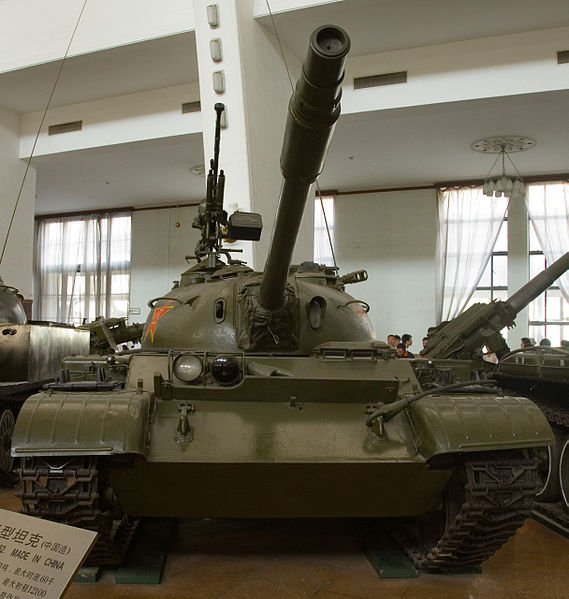
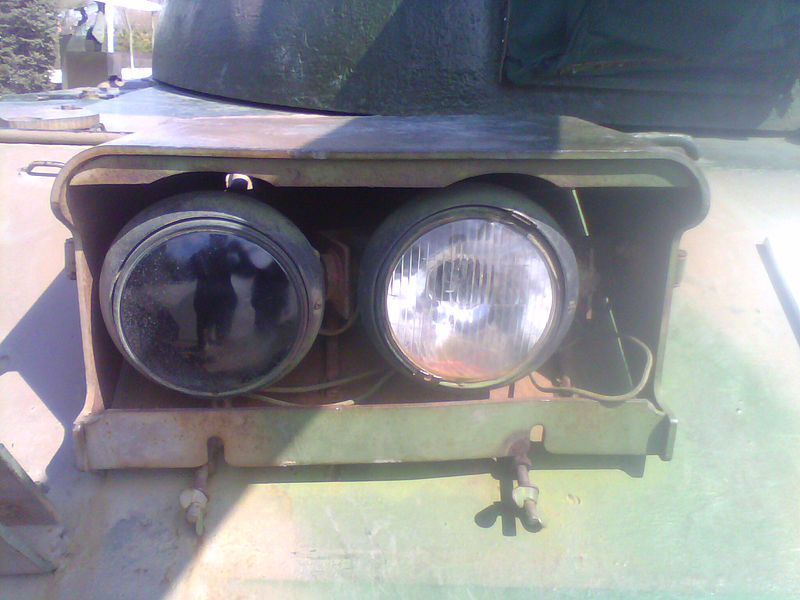
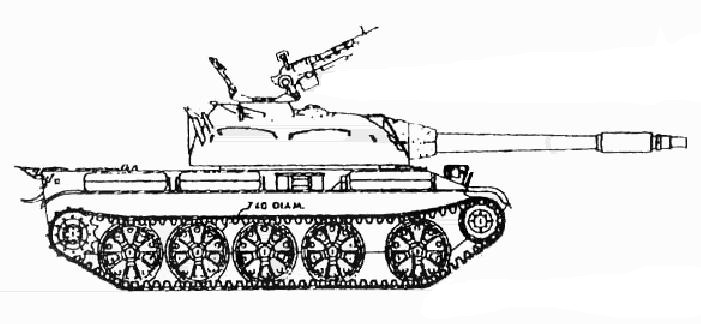
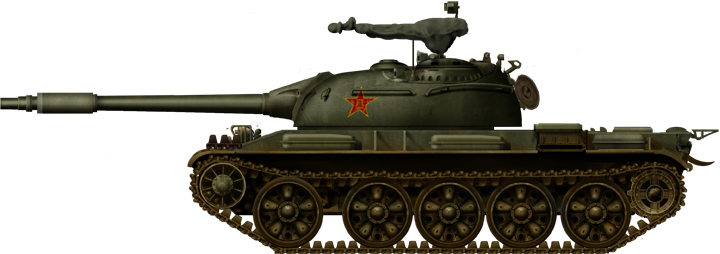
Type 62 of the early production in Southern China, 1963
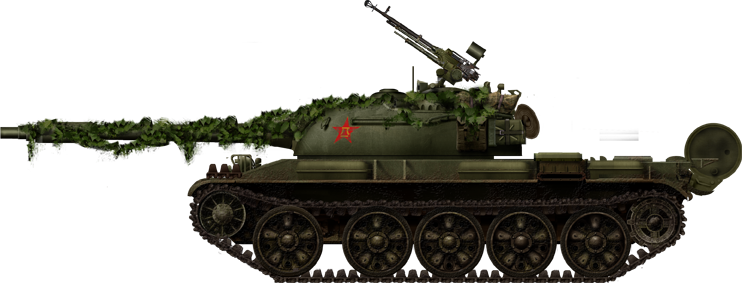
PLA Type 62 in Lạng Sơn, 55th or 42nd Corps, North Vietnam, Sino-Vietnamese war of 1979.
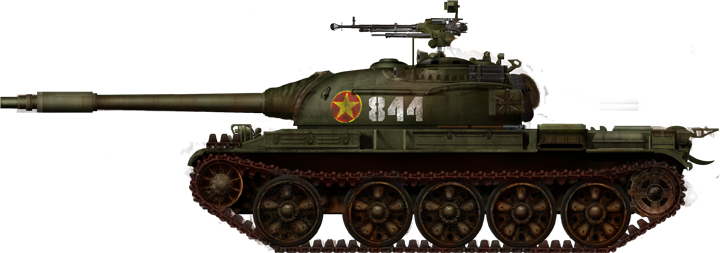
North Vietnamese Type 62, Têt offensive, 1968.
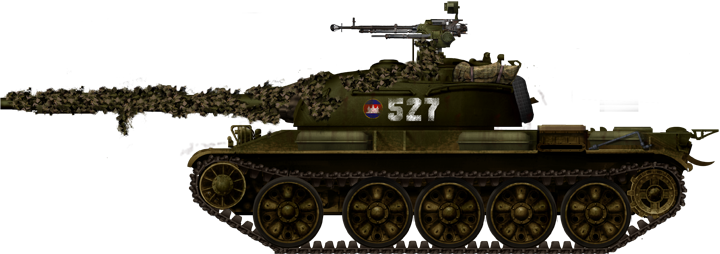
Cambodian Type 62.
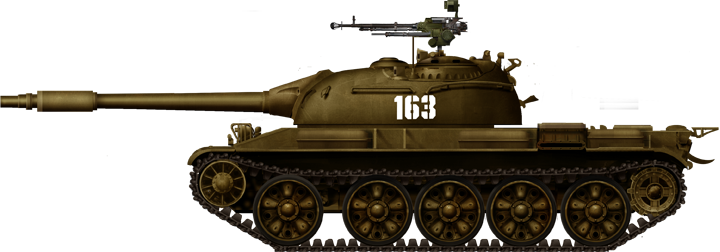
Type 62 from Laos (according to the China defence blog). Possibly inherited from the NVA forces.
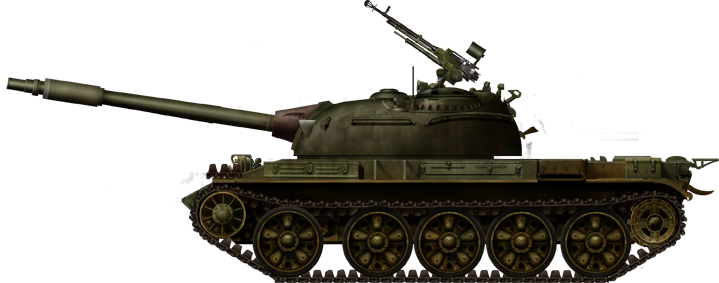
Congolese Type 62, apparently retaining its green livery, with no markings and no gun mantlet canvas protection.
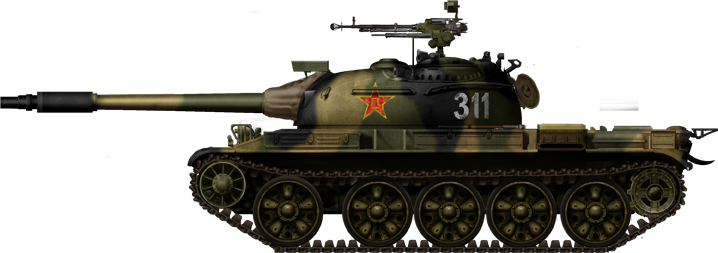
Type 62-I (early-production) in the early 1980s.
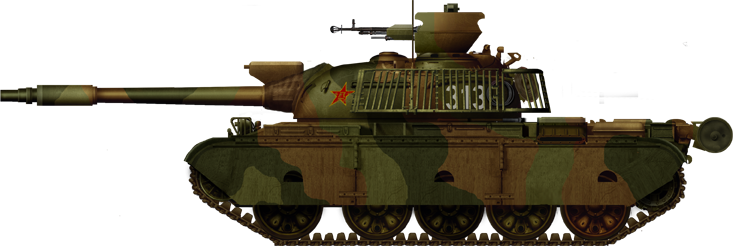
Type 62-I (late-production) in the 1990s.
 Type 62 G in 2005 (saw in CCTV, possibly of the organic recce unit of the Guangzhou MR artillery regiment.
Type 62 G in 2005 (saw in CCTV, possibly of the organic recce unit of the Guangzhou MR artillery regiment.

Cold War Tanks


































Cold war tanks posters

Cold War Main Battle Tanks

Cold War Soviet Army

